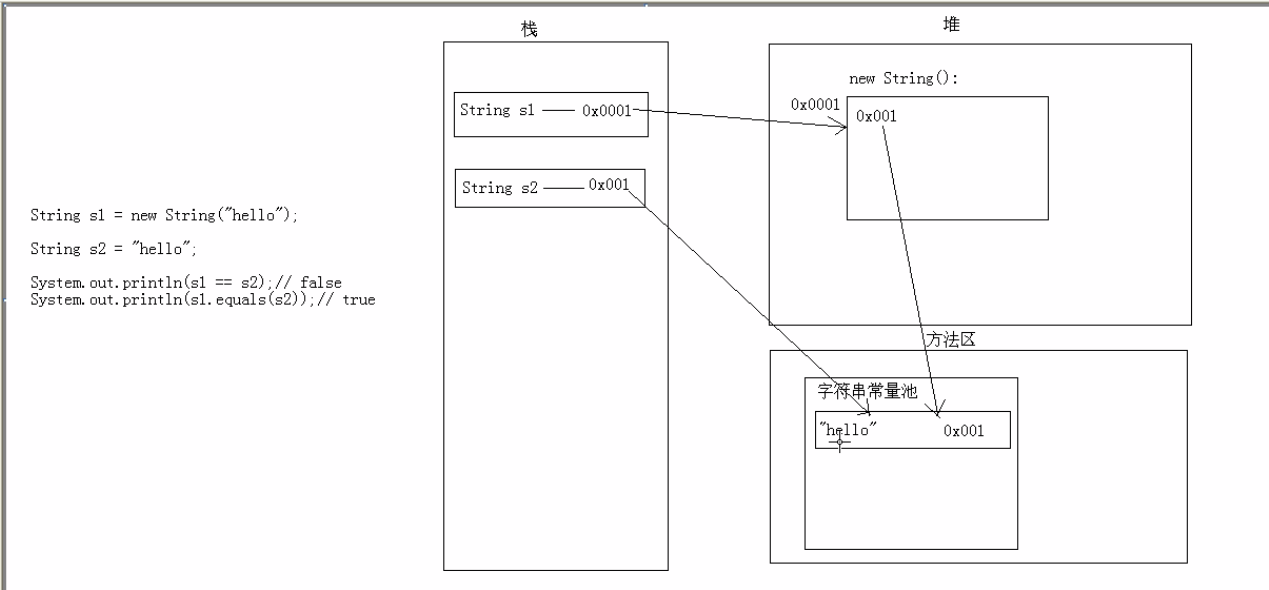1、Scanner:用于接收键盘录入的数据。
(1)System类下有一个静态的字段:
public static final InputStream in; //标准的输入流,对应着键盘录入。
例1:
InputStream is = System.in;
(2)构造方法:
Scanner(InputStream source);
(3)基本格式:
public boolean hasNextXxx():判断是否是某种类型的元素
public Xxx nextXxx():获取该元素
例2:
Scanner sc = new Scanner(System.in);
if (sc.hasNextInt()) {
int x = sc.nextInt();
System.out.print;n(x);
} else {
System.out.println("您输入的数据有误!");
}
(4)例3:
Scanner sc = new Scanner(System.in);
int x = sc.nextInt();
String str = sc.nextLine();
System.out.println("x:" + x + " str:" + str);
输入 10 后,直接输入 x:10 str:
出现问题了:
先获取一个数值,再获取一个字符串,就会出现问题。
主要原因:就是那个换换行符号的问题。
如何解决?
A:先获取一个数值后,再创建一个新的键盘录入对象获取字符串。(两个键盘录入对象)
B:把所有的数据都先按照字符串获取,然后要什么,你就对应转换成什么。
2、String
(1)字符串:就是由多个字符组成的一串数据,也可以看成时一个字符数组。
通过查看API,我们可以知道
A:字符串字面值“abc”也可以看成一个字符串对象。
B:字符串是常量,一旦被赋值,就不能被改变。
(2)构造方法:
public String():无参构造
public String(byte[] bytes):把字节数组转成字符串
public String(byte[] bytes, int offset, int length):把字节数组中从offset开始长度为length的转成字符串
public String(char[] value):把字符数组转成字符串
public String(char[] value, int offset, int count):把字符数组中从offset开始长度为length的转成字符串
public String(String original):把字符串常量值转成字符串
(3)字符串特点:
A:字符串直接赋值的方式是先到字符串常量池中去找,如果由就直接返回,没有,则创建并返回。
B:一旦被赋值就不能被改变。
(4)面试题:String s = new String("hello"); 和 String s = "hello";的区别?
有,前者创建两个对象,后者创建一个。 
(5)面试题:看程序写结果
String s1 = "hello";
String s2 = "world";
String s3 = "helloworld";
System.out.println(s3 == s1 + s2); //false
System.out.println(s3.equals((s1 + s2))); //true
System.out.println(s3 = "hello" + "world"); //true
System.out.println(s3.equals("hello" + "world")); //true
解析:
A:字符串如果是变量相加,先开空间,再拼接
B:字符串如果是常量相加,是先加,然后再常量池中找,如果有就直接返回,否则,就创建。
(6)String的判断功能:
public boolean equals(Object obj):比较字符串的内容是否相同,区分大小写
public boolean equalsIgnoreCase(Object obj):比较字符串的内容是否相同,忽略大小写
public boolean contains(String str):判断主串中是否包含子串
public boolean startsWith(String str):判断字符串是否以某个指定字符串开头
public boolean endWith(String str):判断字符串是否以某个指定字符串结尾
public boolean isEmpty():判断字符串对象是否为空
注意:
字符串的内容为空和字符串对象为空不同。
内容为空:String s = "";
对象为空:String s = null;
(7)String的获取功能:
public int length():获取字符串的长度
public charAt(int index):获取指定索引位置的字符
public int indexOf(int ch):返回指定字符在此字符串中第一次出现处的索引
为什么这里是int类型,而不是char类型?
原因是:'a' 和 97 其实都可以代表 'a'。
public int indexOf(String str):返回指定字符串在此字符串中第一次出现处的索引
public int indexOf(int ch, int fromIndex):返回指定字符在此字符串中从指定位置后第一次出现处的索引
public int indexOf(String str, int fromIndex):返回指定字符串在此字符串中从指定位置后第一次出现处的索引
public String substring(int start):从指定位置开始截取字符串,默认到结尾,包含start位置的字符
public String substring(int start, int end):从指定位置开始到指定位置结束截取字符串,包含start位置的字符,不包含end位置的字符
(8)String的转换功能:
public byte[] getBytes():把字符串转换为字节数组
public char[] toCharArray():把字符串转换为字符数组
public static String valueOf(char[] chs):把字符数组转换成字符串。
public static String valueOf(int i):把int类型的数据转换成字符串
注意:String类的 valueOf 方法可以把任意类型的数据转换成字符串
public String toLowerCase():把字符串转成小写
public String toUpperCase():把字符串转成大写
public String concat(String str):把字符串拼接
(9)String类的其他功能:
替换功能:
public String replace(char old, char new)
public String replace(String old, String new)
去除字符串两端空格:
pubilc String trim()
按字典顺序比较两个字符串:
public int compareTo(String str)
public compareToIgnoreCase(String str)